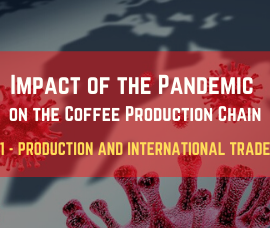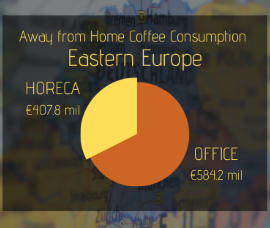5 to GO: Revolutionizing Coffee Culture in Eastern Europe
Launched in 2015, 5 to GO has become the largest coffee chain in Eastern Europe by offering a unique single-price concept and adapting to customer needs. Despite challenges like the pandemic and geopolitical tensions, the brand has maintained competitive prices and high standards. Key differentiators include a unique coffee blend, a welcoming atmosphere, and a focus on healthy options. The founders emphasize the importance of market analysis, customer focus, and staying updated with trends for aspiring entrepreneurs. The coffee culture in Romania has evolved significantly, with increasing demand for quality, diversity, and sustainability expected in the future.
In this episode of Inside the Market, we met Radu Savopol, co-founder of the coffee chain 5 to GO in Romania.
Since its inception, 5 to Go has grown significantly. Can you share some key milestones in the chain’s expansion?

We launched 5 to Go in 2015, with the vision to develop a business in the to-go segment, also bringing to the HoReCa market in Romania the innovative concept of a single price for all the products sold. The story started with a small coffee shop we opened in the Old Center of Bucharest and then, after promising feedback, we developed the franchise system and our growth was exponential. 5 to Go is currently the largest coffee chain in Eastern Europe and the most accessed HoReCa franchise in Romania, aiming to reach a threshold of 1,000 locations in the country in the next 4 years and to continue its expansion internationally.
The market we operate in is full of challenges, so we went through different difficult stages during all these years, like the coronavirus pandemic, the war going on at our border, and the resulting fragile economic context, which had a significant impact on the business and decision-making concerning our price range, portfolio, and also our development strategy.
What inspired you to start 5 to Go, and what was your vision for the brand when you first launched it?
Back in 2015, the concept of coffee-to-go was an upward trend worldwide, and we decided to implement that business model in Romania, responding to a need we detected at the time. Lucian and I created the concept and the business plan very quickly and, as we predicted, it worked great. We’ve always kept an eye on the big brands, watched their progress, and how the public received the decisions they’ve made over time. I think it is very important to take part in big global industry events, meet people, and widen your vision with new ideas.
So, we continue to be inspired by trends, but our first source of inspiration is our customers, who help us improve and develop. We adapt to their needs, and this is one of the assets that makes us relevant in the market.
How do you decide on the coffee blends and menu items offered at 5 to Go? Do you have a particular approach to sourcing your coffee beans?
The coffee we use has an intense, full-bodied, creamy aroma, a unique blend of Arabica from Brazil, and the finest varieties from Colombia, created especially for the 5 to Go chain of cafes, so it cannot be found anywhere else.

What do you believe sets 5 to Go apart from other coffee chains in terms of customer experience?
We try to get to know our consumers as well as we can. We talk to them, watch their habits, and analyze their feedback. For instance, more and more people are preoccupied with nutrition and making healthier choices, so we are offering them a wide range of options, including bio, organic, vegan, or sugar-free products. We are constantly launching new recipes, innovative and surprising items. We’ve even done market studies to reveal brand awareness, customer perception of prices, and main reasons for consuming 5 to Go products, making it easier for us to meet their evolving needs.
Also, since the very beginning, we managed to create a cozy and welcoming atmosphere in the cafes, to offer the best consumption experience possible, meaning not only good coffee but a tasting experience, including socializing, faster service, good attitude, relaxation, and diversity.
In addition, proximity is one of our strategic pillars: 5 to Go covers more than 120 cities in Romania, so we are close to our consumers wherever they are and we offer them good quality products at a good price.
How have recent geopolitical events in Europe affected your business operations in Romania?
Due to inflation, legislative changes, and other factors out of our control, prices are rising, including the price of coffee, while customers tend to be more cautious when shopping, trying to save money. So we have done everything to maintain competitive prices for as long as possible, without sacrificing our high standards, only increasing them where unavoidable. This way, our business has remained profitable.
How do fluctuations in the global coffee market, influenced by geopolitical tensions, impact your supply chain?
The cost and availability of products, including coffee, are affected by geopolitical tensions worldwide. Despite this, we managed to adapt, achieve our goals, and even exceed them. We are proud of our accomplishments under these conditions.
What advice would you give to aspiring entrepreneurs who are looking to start their own coffee businesses?
There is no generally valid recipe for success; every person and every field of activity differ and come with their own specific challenges. But it is important as an entrepreneur to analyze the market, to be permanently connected with the trends, and to put customers at the heart of your business, to be close to them and offer them high-quality services.

How has the coffee culture in Romania evolved over the last 30 years?
One of our first challenges as a brand was building a coffee culture in Romania because it was not developed at all back then. People were drinking very poor-quality and very cheap coffee they could buy from vending machines. We have provided a quality alternative at the right price, and if they have where to choose from, of course, customers will go for the best option they can afford. Even now there are things to improve, which is why we try to permanently acknowledge market preferences and anticipate trends.
What trends or future do you see for coffee in the next 5 years?
It is an unpredictable market; things can change significantly from one year to another. Among the upward trends, I would mention increasing customers’ expectations for quality, diversity, and sustainability, which must become a constant concern for any brand in this segment in the coming years.



